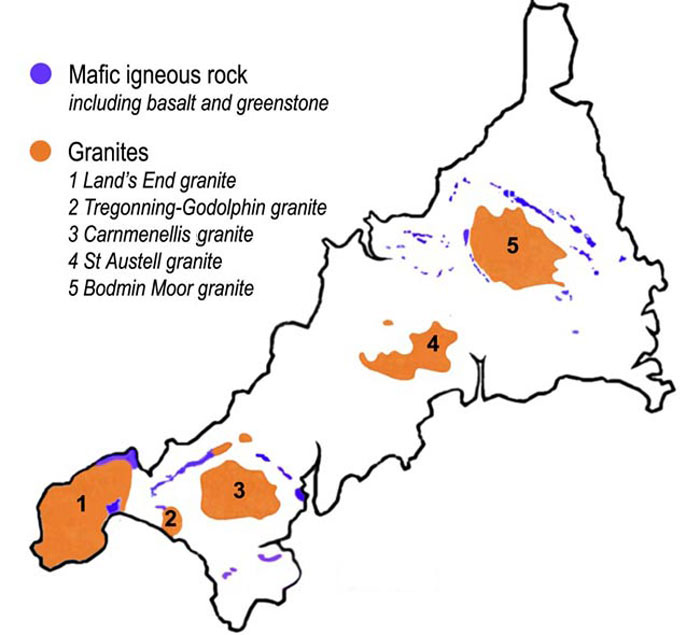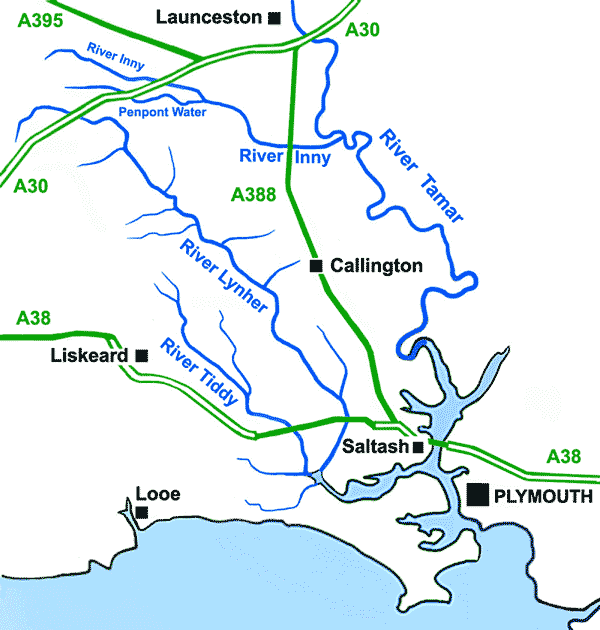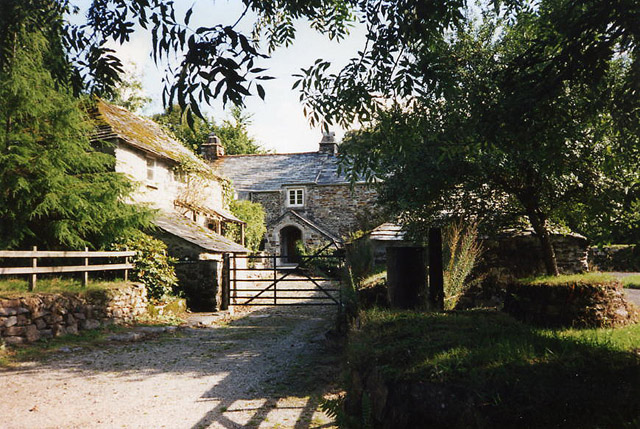|
St Clether
St Clether is a civil parish and village in Cornwall, England, United Kingdom. The village is situated on the east flank of Bodmin Moor approximately eight miles (13 km) west of Launceston in the valley of the River Inny. The population of the civil parish at the 2011 census was 156. The original Norman church of St Clederus was, apart from the tower, rebuilt in 1865. The tower is built of granite and is of late medieval date; the font is Norman and very plain. West of St Clether parish church is a holy well and associated chapel, said to be one of Cornwall's best preserved. The church and holy well are dedicated to Saint Cleder (or Clederus), one of the twenty-four children of Saint Brychan, a Welsh saint and King of Brycheiniog Brycheiniog was an independent kingdom in South Wales in the Early Middle Ages. It often acted as a buffer state between England to the east and the south Welsh kingdom of Deheubarth to the west. It was conquered and pacified by the N ... [...More Info...] [...Related Items...] OR: [Wikipedia] [Google] [Baidu] |
Civil Parishes In England
In England, a civil parish is a type of Parish (administrative division), administrative parish used for Local government in England, local government. It is a territorial designation which is the lowest tier of local government below districts of England, districts and metropolitan and non-metropolitan counties of England, counties, or their combined form, the Unitary authorities of England, unitary authority. Civil parishes can trace their origin to the ancient system of Parish (Church of England), ecclesiastical parishes, which historically played a role in both secular and religious administration. Civil and religious parishes were formally differentiated in the 19th century and are now entirely separate. Civil parishes in their modern form came into being through the Local Government Act 1894, which established elected Parish councils in England, parish councils to take on the secular functions of the vestry, parish vestry. A civil parish can range in size from a sparsely ... [...More Info...] [...Related Items...] OR: [Wikipedia] [Google] [Baidu] |
Cornwall
Cornwall (; kw, Kernow ) is a historic county and ceremonial county in South West England. It is recognised as one of the Celtic nations, and is the homeland of the Cornish people. Cornwall is bordered to the north and west by the Atlantic Ocean, to the south by the English Channel, and to the east by the county of Devon, with the River Tamar forming the border between them. Cornwall forms the westernmost part of the South West Peninsula of the island of Great Britain. The southwesternmost point is Land's End and the southernmost Lizard Point. Cornwall has a population of and an area of . The county has been administered since 2009 by the unitary authority, Cornwall Council. The ceremonial county of Cornwall also includes the Isles of Scilly, which are administered separately. The administrative centre of Cornwall is Truro, its only city. Cornwall was formerly a Brythonic kingdom and subsequently a royal duchy. It is the cultural and ethnic origin of the Cornish dias ... [...More Info...] [...Related Items...] OR: [Wikipedia] [Google] [Baidu] |
Bodmin Moor
Bodmin Moor ( kw, Goon Brenn) is a granite moorland in north-eastern Cornwall, England. It is in size, and dates from the Carboniferous period of geological history. It includes Brown Willy, the highest point in Cornwall, and Rough Tor, a slightly lower peak. Many of Cornwall's rivers have their sources here. It has been inhabited since at least the Neolithic era, when primitive farmers started clearing trees and farming the land. They left their megalithic monuments, hut circles and cairns, and the Bronze Age culture that followed left further cairns, and more stone circles and stone rows. By medieval and modern times, nearly all the forest was gone and livestock rearing predominated. The name Bodmin Moor is relatively recent. An early mention is in the ''Royal Cornwall Gazette'' of 28 November 1812. The upland area was formerly known as Fowey Moor after the River Fowey, which rises within it. Geology Bodmin Moor is one of five granite plutons in Cornwall that make up pa ... [...More Info...] [...Related Items...] OR: [Wikipedia] [Google] [Baidu] |
Launceston, Cornwall
Launceston ( or , locally or , kw, Lannstevan; rarely spelled Lanson as a local abbreviation) is a town, ancient borough, and civil parish in Cornwall, England, United Kingdom. It is west of the middle stage of the River Tamar, which constitutes almost the entire border between Cornwall and Devon. The landscape of the town is generally steep particularly at a sharp south-western knoll topped by Launceston Castle. These gradients fall down to the River Kensey and smaller tributaries. The town centre itself is bypassed and is no longer physically a main thoroughfare. The A388 still runs through the town close to the centre. The town remains figuratively the "gateway to Cornwall", due to having the A30, one of the two dual carriageways into the county, pass directly next to the town. The other dual carriageway and alternative main point of entry is the A38 at Saltash over the Tamar Bridge and was completed in 1962. There are smaller points of entry to Cornwall on minor ... [...More Info...] [...Related Items...] OR: [Wikipedia] [Google] [Baidu] |
River Inny, Cornwall
The River Inny ( kw, Dowr Enni) is a small river in east Cornwall, United Kingdom. It is a tributary of the River Tamar and is about long from its source near Davidstow on the eastern flank of Bodmin Moor to its confluence with the Tamar at Inny Foot near Dunterton. The River Inny's catchment is 108 square kilometres. Penpont Water is the main tributary and joins the Inny at Two Bridges. Cornwall Rivers Project website; River Inny; retrieved April 2010 The course of the River Inny is initially east-southeast. From Two Bridges it runs southeast before running due east for the last few miles to its confluence with the Tamar. The River Inny supports , [...More Info...] [...Related Items...] OR: [Wikipedia] [Google] [Baidu] |
Holy Well
A holy well or sacred spring is a well, spring or small pool of water revered either in a Christian or pagan context, sometimes both. The water of holy wells is often thought to have healing qualities, through the numinous presence of its guardian spirit or Christian saint. They often have local legends associated with them; for example in Christian legends, the water is often said to have been made to flow by the action of a saint. Holy wells are often also places of ritual and pilgrimage, where people pray and leave votive offerings. In Celtic regions, strips of cloth are often tied to trees at holy wells, known as clootie wells. Names The term ''haeligewielle'' is in origin an Anglo-Saxon toponym attached to specific springs in the landscape; its current use has arisen through folklore scholars, antiquarians, and other writers generalising from those actual 'Holy Wells', which survived into the modern era. The term 'holy-hole' is sometimes employed.A. Ross, ''Pagan Celt ... [...More Info...] [...Related Items...] OR: [Wikipedia] [Google] [Baidu] |
Brychan
Brychan Brycheiniog was a legendary 5th-century king of Brycheiniog (Brecknockshire, alternatively Breconshire) in Mid Wales. Life According to Celtic hagiography Brychan was born in Ireland, the son of a Prince Anlach, son of Coronac, and his wife, Marchel, heiress of the Welsh kingdom of Garthmadrun (Brycheiniog), which the couple later inherited. Upon his father's death, he returned to Garthmadrun and changed its name to Brycheiniog. Brychan's name may be a Welsh version of the Irish name Broccán and that of his grandfather Coronac may represent Cormac. Brychan's education was entrusted to one Drichan. The ''Life of St. Cadoc'' by Lifris (''c''. 1100) portrays Brychan fighting Arthur, Cai and Bedivere because of King Gwynllyw of Gwynllwg's abduction of his daughter St. Gwladys from his court in Talgarth. Portraiture and veneration He is occasionally described as an undocumented saint but the traditional literature does not call him a saint, referring to him as a patria ... [...More Info...] [...Related Items...] OR: [Wikipedia] [Google] [Baidu] |
Welsh People
The Welsh ( cy, Cymry) are an ethnic group native to Wales. "Welsh people" applies to those who were born in Wales ( cy, Cymru) and to those who have Welsh ancestry, perceiving themselves or being perceived as sharing a cultural heritage and shared ancestral origins. Wales is the third-largest Countries of the United Kingdom, country of the United Kingdom of Great Britain and Northern Ireland. In the Acts of Union 1707, the Kingdom of England and the Kingdom of Scotland merged to become the Kingdom of Great Britain. The majority of people living in Wales are British nationality law, British citizens. In Wales, the Welsh language ( cy, Cymraeg) is protected by law. Welsh remains the predominant language in many parts of Wales, particularly in North Wales and parts of West Wales, though English is the predominant language in South Wales. The Welsh language is also taught in schools throughout Wales, and, even in regions of Wales in which Welsh people predominantly speak English ... [...More Info...] [...Related Items...] OR: [Wikipedia] [Google] [Baidu] |
Saint
In religious belief, a saint is a person who is recognized as having an exceptional degree of Q-D-Š, holiness, likeness, or closeness to God. However, the use of the term ''saint'' depends on the context and Christian denomination, denomination. In Catholic Church, Catholic, Eastern Orthodox Church, Eastern Orthodox, Anglican Communion, Anglican, Oriental Orthodox, and Lutheranism, Lutheran doctrine, all of their faithful deceased in Heaven are considered to be saints, but some are considered worthy of greater honor or emulation. Official ecclesiastical recognition, and consequently a public cult of veneration, is conferred on some denominational saints through the process of canonization in the Catholic Church or glorification in the Eastern Orthodox Church after their approval. While the English word ''saint'' originated in Christianity, History of religion, historians of religion tend to use the appellation "in a more general way to refer to the state of special holiness t ... [...More Info...] [...Related Items...] OR: [Wikipedia] [Google] [Baidu] |
Brycheiniog
Brycheiniog was an independent kingdom in South Wales in the Early Middle Ages. It often acted as a buffer state between England to the east and the south Welsh kingdom of Deheubarth to the west. It was conquered and pacified by the Normans between 1088 and 1095, though it remained Welsh in character. It was transformed into the Lordship of Brecknock and later formed the southern and larger part of the historic county of Brecknockshire. To its south was the Kingdom of Morgannwg. The main legacy of the kingdom of Brycheiniog is etymological. It has lent its name to Brecknockshire (Welsh: ''Sir Frycheiniog'', the shire of Brycheiniog) and Brecon (known as ''Aberhonddu'' in Welsh). History Origins Brycheiniog belonged to the Demetae in pre-Roman times. In Welsh tradition, it was given by the Roman governor of Brittania, Magnus Maximus (''Macsen Wledig'' in Welsh), to a Greek named ''Antonius the Black'' (''Anwn Ddu''). Some Welsh legends describe Antonius as Maximus' son, an ... [...More Info...] [...Related Items...] OR: [Wikipedia] [Google] [Baidu] |
John MacLean (historian)
Sir John Maclean KB, FSA (17 September 1811 – 5 March 1895) was a British civil servant, genealogist and author. Life Maclean was born John Lean, a son of Robert Lean, of Trehudreth in the parish of Blisland in Cornwall, where he was born in 1811. His mother was Elizabeth Every, a daughter of Thomas Every, of Bodmin, Cornwall. After genealogical research his ancestors were connected to the Scottish Clan Maclean, and in 1845, with his brothers, he added to his surname the prefix "Mac". In 1837 he entered the Ordnance Department of the War Office, and became deputy auditor in April, 1865. He resigned this post on a pension, and received a knighthood in January, 1871. Sir John Maclean died at his residence, Glasbury House, Richmond Hill, Clifton, Bristol, of influenza. on Tuesday 5 March 1895. Family In 1835 at Helland in Cornwall, he married Mary Billing, eldest sister and co-heiress of Thomas Billing, of Lanke, Cornwall. Writings Sir John's ''Parochial History of the Deaner ... [...More Info...] [...Related Items...] OR: [Wikipedia] [Google] [Baidu] |
Civil Parishes In Cornwall
A civil parishes in England, civil parish is a country subdivision, forming the lowest unit of local government in England, local government in England. There are 218 civil parishes in the ceremonial county of Cornwall, which includes the Isles of Scilly. The county is effectively parished in its entirety; only the unpopulated Wolf Rock, Cornwall, Wolf Rock is unparished. At the United Kingdom Census 2001, 2001 census, there were 501,267 people living in the current parishes, accounting for the whole of the county's population. The final unparished areas of mainland Cornwall, around St Austell, were parished on 1 April 2009 to coincide with the 2009 structural changes to local government in England, structural changes to local government in England. Population sizes within the county vary considerably, Falmouth, Cornwall, Falmouth is the most populous with a population of 26,767, recorded in 2011, and St Michael's Mount the least with 29 residents. The county is governed by two ... [...More Info...] [...Related Items...] OR: [Wikipedia] [Google] [Baidu] |



_Eglwys_Aberhonddu_(Brecon%2C_Wales)_02.jpg)


